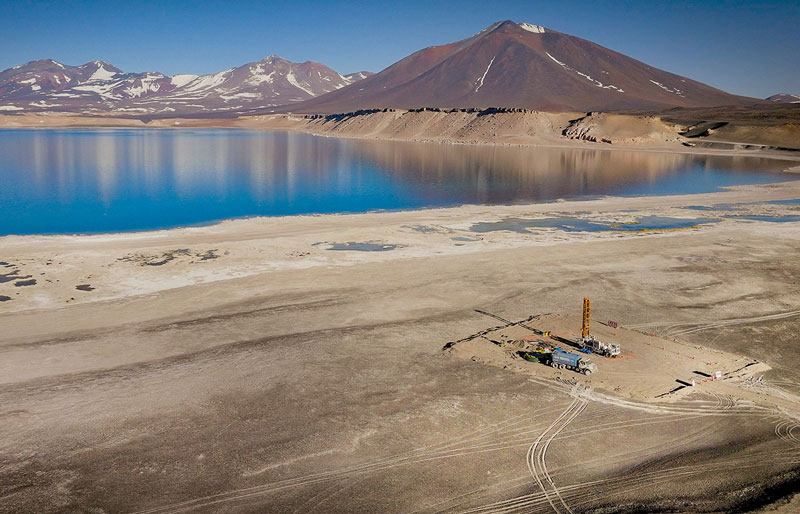Two new lithium projects are underway in northern Chile, Laguna Verde (the most advanced) and Viento Andino, by CleanTech Lithium (CTL), a Chile-based exploration and development company.
The company told Revista Minería Pan-Americana that “after several successful drilling campaigns starting in 2021, we are in the process of completing a drilling program at Laguna Verde, the results of which will feed into a resource update and the declaration of the first reserve estimate for our most advanced lithium project.”
This update will be incorporated into the Pre-Feasibility Study (PFS). The PFS will be completed in the first quarter of 2025, “then we will focus on the delivery of the Final Feasibility Study and the Environmental Impact Assessment (EIA) and we will move from the exploration and technical analysis phase to the development and construction phase,” CTL said.
At Viento Andino, a plan is underway for an additional drilling program with potential resource increases. For now, Laguna Verde is the center of attention to move towards the construction phase.
The lithium process
The company recently published a plant siting study as part of its ongoing PFS for the Laguna Verde project, which resulted in the decision to locate the DLE and eluate concentration stages at the project site while the carbonation plant in Copiapó. This will have several benefits, such as the reduction of the footprint and impacts on Laguna Verde, and the use of the existing infrastructure, energy supply and existing skilled labor in Copiapó. “The Copiapó plant will be able to be expanded to treat material from our Viento Andino project and potentially others. The decision on the configuration of the plant will be included directly in the PFS,” CleanTech Lithium commented.
As for the first batch of concentrated eluate, which was sent to Conductive Energy, the brine from the Laguna Verde project is stored in a large 243,000-litre container outside the pilot plant and then fed into an inner tank after having gone through a filtration process to remove suspended solids. It is then fed into the DLE columns, which are filled with adsorbent designed to be selective with lithium molecules. Lithium, in the form of chloride, is adsorbed from brine, prior to desorption with water to create a purified lithium chloride eluate.
A reverse osmosis (RO) unit at DLE’s pilot plant then concentrates the eluate by extracting approximately 75% of the water before this concentrated eluate is sent to Conductive Energy’s facility in Chicago, USA, for conversion into lithium battery carbonate.
Notably, a batch of 200 liters of concentrated eluate was airlifted to Conductive Energy for optimization testing of the planned conversion process. The results of these tests were very positive, indicating that the brine from Laguna Verde can be converted into lithium carbonate for batteries.
Following this optimisation process, larger volumes of concentrated eluate have also been shipped in 24 m³ containers that will be processed into lithium carbonate for batteries in the fourth quarter of 2024.
Brine is extracted from the basin’s aquifer and pumped to a treatment unit where a resin or adsorption material is used to selectively extract lithium, while spent brine is reinjected into the basin’s aquifers with minimal aquifer depletion or minimal damage to the environment.
The resin adsorbs lithium chloride (LiCl) molecules on the surface of the material and rejects almost all impurities in the brine. The lithium chloride is then separated from the resin with water, creating a purified lithium chloride eluate. This eluate is then concentrated using reverse osmosis and direct osmosis before standard industrial processes are used to remove the remaining impurities and produce lithium carbonate for batteries.
Renewable energy
CleanTech Lithium plans to use renewable energy, “which will be possible thanks to the connection to Chile’s energy grid, which contains one of the highest levels of renewable energy in the world.” Importantly, the DLE process and the reinjection of spent brine aim to reduce net water consumption to less than 2 m³ per ton of LCE, or 50 times less than existing production in evaporation ponds in Chile, according to peer-reviewed reports.
By utilizing renewable energy with DLE, CTL is laying a solid foundation to deliver a premium supply of “green” lithium for the electric vehicle and energy storage market.
Next steps
The immediate next steps include obtaining the Special Lithium Exploitation Contract (CEOL) with the Chilean government; current lines of work include regular constructive engagement with government and regulatory bodies, devoting considerable time and resources to local community relations, and advancing the ongoing PFS and EIA for Laguna Verde.
Accordingly, CTL will be subject to financing and partner acquisition agreements. Partners could be, for example, electric vehicle manufacturers, battery manufacturers, and international trading companies, among others. The timing of partnership and financing negotiations is based on having the right levels of information available through ongoing work programmes to facilitate constructive engagement and maximise shareholder value.
Other ongoing lines of work that represent a turning point for the delivery of commercial production include reaching a power purchase agreement to access renewable energy for the large-scale DLE plant and advancing the other necessary regulatory approvals.
The Government of Chile has expressed its desire for between three and four lithium projects to be developed by 2026, provided that local communities are consulted and sustainable technologies are developed to extract lithium. “We believe that we are one of the most advanced DLE-based projects in Chile and, with an early commitment process and an alliance signed jointly with local communities, we are confident that we can help the Government achieve this goal,” the company concluded.

